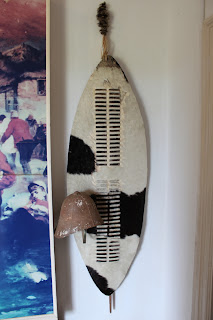The following photos are somewhat random.
This is a four-generation picture of the Sabisa family from the Dundee Branch. Because the Church is so new here, it is unusual to have multiple generations in the Church. Many are the first of their families to join. The Sabisas are very strong members and real leaders in Dundee.
Of course, I must include some wildlife pictures. This is a Cape White-Eye taking a morning bath at a bubbler.
Thabile Dlamini, after finishing her PEF online application. Always a time to celebrate. It is supposed to be quite a simple process but believe me, it is anything but easy. With computers you can never be sure of what will happen and something usually does. But we keep at it and eventually have success.
We actually can see the ocean from our flat on a clear day. Between the two hills, you can see a faint blue line. That is the Indian Ocean. It is usually not clear enough to see it.
Our Ladysmith PEF Workshop class. Khulisile, Nomvuzo, and Sibahle. These girls are all so sharp and did so well in the classes. They will surely be good students at college. We already are wondering what their lives will be like 10 years from now. We want so much for them to have what we have. Though Americans are aware of how blessed we are, it is not really driven home until you see it otherwise first hand.
Two young men from Isandhlwana who came running when we offered them some sweets. They were thrilled with a treat. It was a school day and they spoke very little English, so not sure why they were not attending.
Isandhlwana the site of a huge battle between the Zulus and British. It is kind of like the Battle of Little Bighorn. The British invaded Zululand on trumped up charges and grossly underestimated the Zulu's resolve. About 1300 of their soldiers lost their lives as a result. They were attacked by 25-30,000 warriors. The white cairns mark the places where, after almost a year, the British were able to come back and bury the dead. Of course the Zulus won that battle but lost the war. Interestingly, the memorial is run by and a little town that is nearby consists of, all Zulus.
Our PEF Workshop class at Dundee. Back row L-R Canute Nhlengethwa, Angela, Sabisa, Sphesilhe Hlatshwayo, Simphiwe Ntsele, Bongokuhle Limba. Front L-R Belinda Sabisa, Siphiwe Sabisa, Gabisile Mbhele, Busisiwe Sikhakhane and Charmaine Ntuli.
We just love the look of the roofs made of reeds. We see them even on very expensive houses. Notice the cap of cement on the top to seal the seam and make it leak proof.
Southern Bishops. They are usually so skittish that they fly the moment we slow down but these let us get a picture.
Just had to have a picture of this sign. The cow looks like it got stuck trying to get over the gate
A better shot of a Grey Heron in a field just as we were leaving a gas station.
Wheelbarrows are the most common mode of transport in so many of the rural areas. He has water barrels in it and is headed to get water. Where, you might ask?
In his case and for others of the area, to the fire truck, which was filling their containers. This was taken just outside Ladysmith in Roosboom, a very poor township. Might see this in the US when there is a natural disaster or something, but very day-to-day here.
Calving season in the spring of South Africa-November. I think these calves have it pretty easy compared to springtime in eastern Oregon. They obviously have a lot of Brahma in them from the looks of their floppy ears.
A reconstructed building at Rorke's Drift where, after annihilating the British Army, 4,000 Zulus attacked 100 British Soldiers. The Zulus were going against the orders of their king but were anxious to dip their spears in blood--a sign of valor. The battle started at 4:30PM and lasted all night. The British prevailed losing only 17 men. Eleven Victoria Crosses were won here. Watch the movie Zulu starring Michael Caine for a somewhat inaccurate but interesting movie about the battle.
A Zulu warrior shield and British helmet from the war.
Outside the museum at Rorke's Drift they piled stones to recreate the sacks of corn the defenders piled up for protection. This lizard lives in them. We have seen them around Pinetown but they always scamper off at first sight of us. This one must be somewhat used to people. It is a Southern Tree Agama but also lives in rocks. Males have this blue head during the breeding season
A closer view. Wouldn't my grandsons love to catch one of these. They are about 1 foot long
Can you guess what these are? Email your answers. No prize, but bragging rights to the first person answering correctly.
Guinea Fowl are quite common but kind of hard to photograph. This one wanted its picture taken as it held the pose and then ran off.
Just a photo trying give everyone an idea of the landscape in western KwaZulu-Natal. It is so green and pretty at this time of year
Two colors of purple.
 |
| Little League in South Africa--Practicing pitching for cricket. |




















































